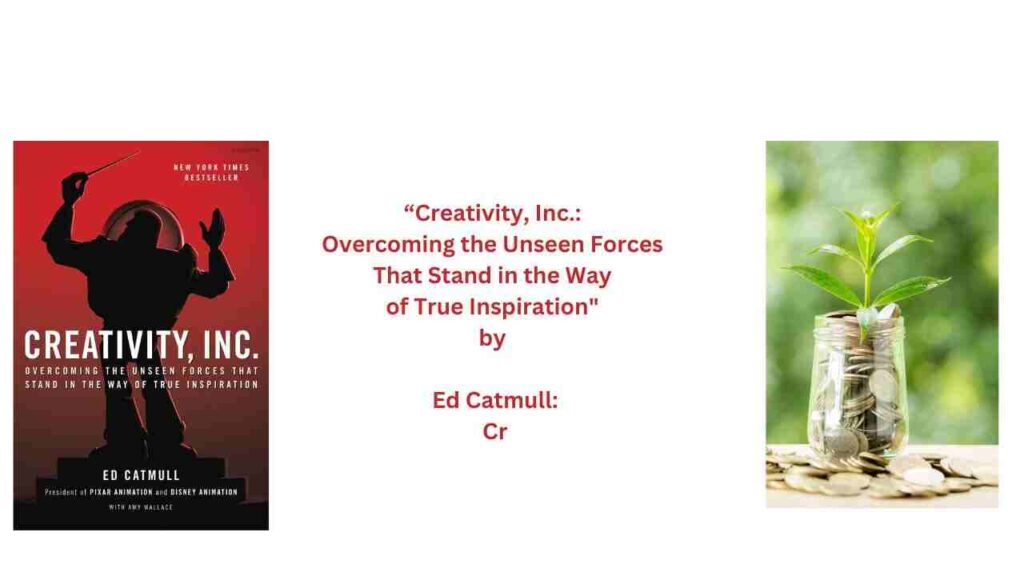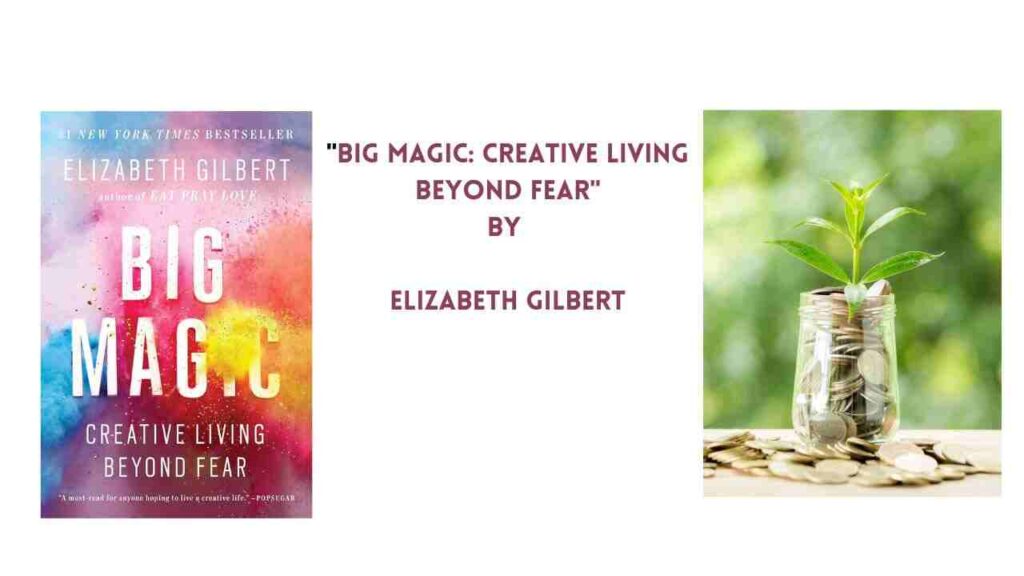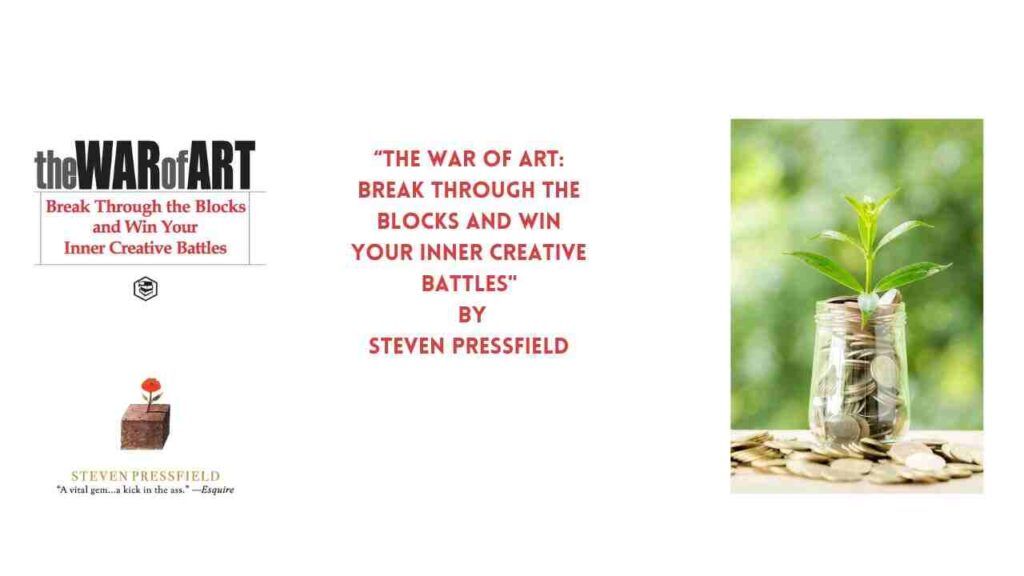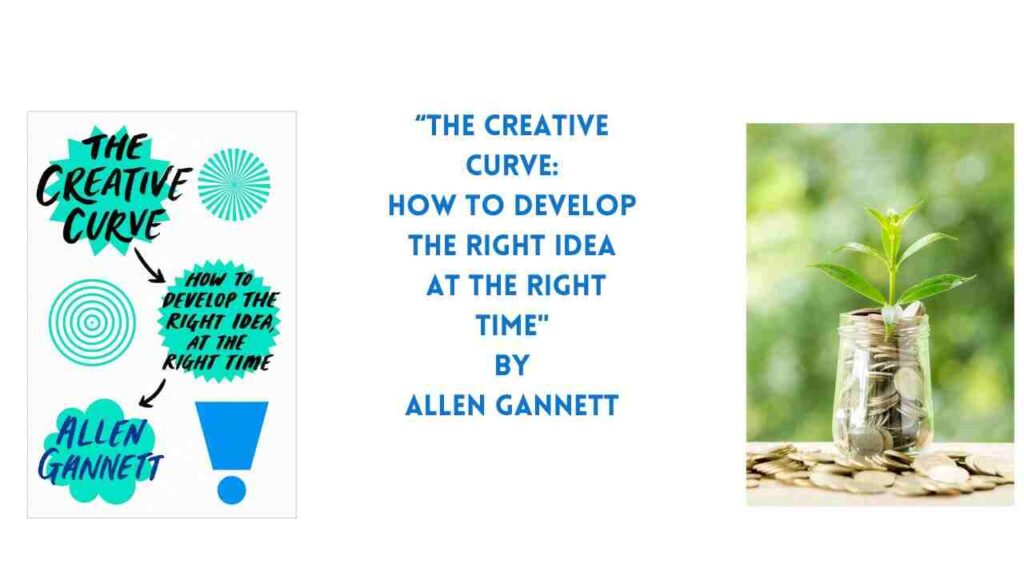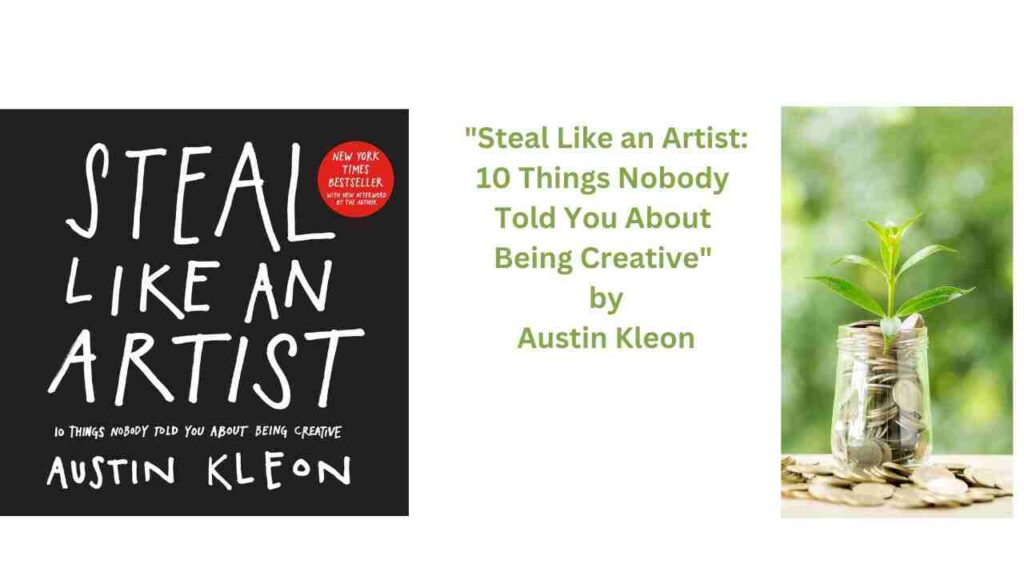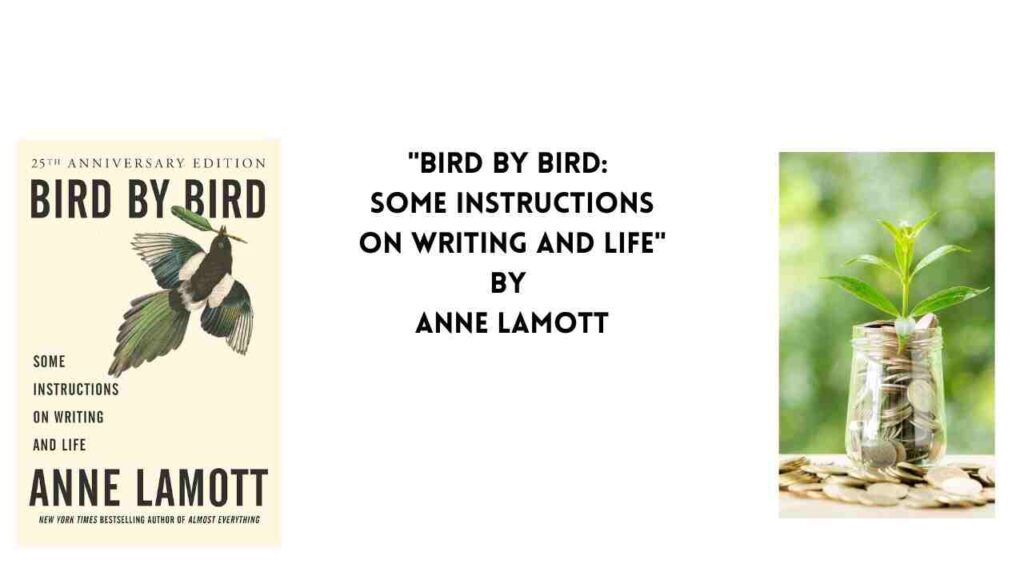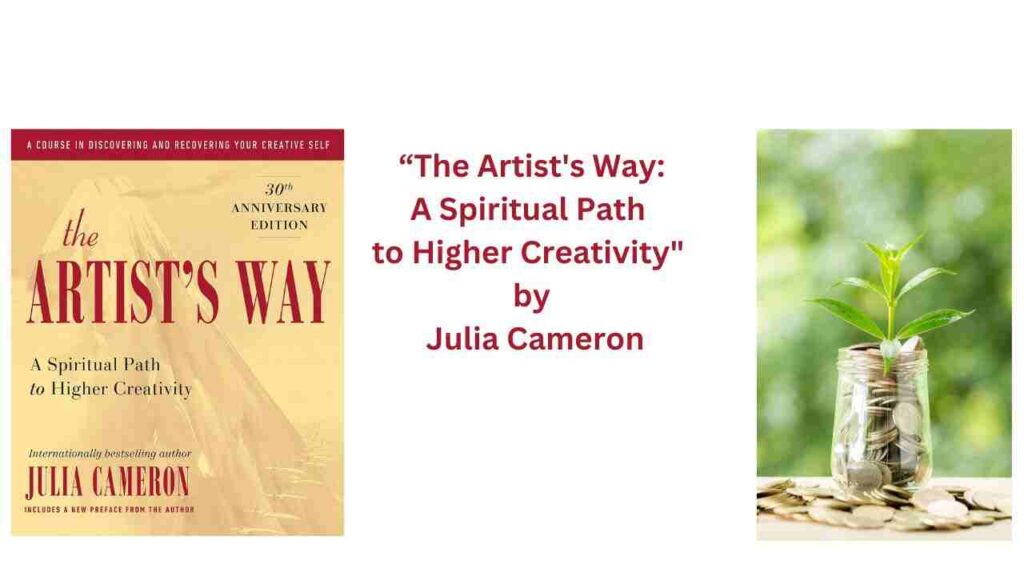best books on creativity hacks||best books on how to develop creativity
disclaimer: All products featured on this website are independently selected by us. However, when you buy something through our retail links, we may earn an affiliate commission.
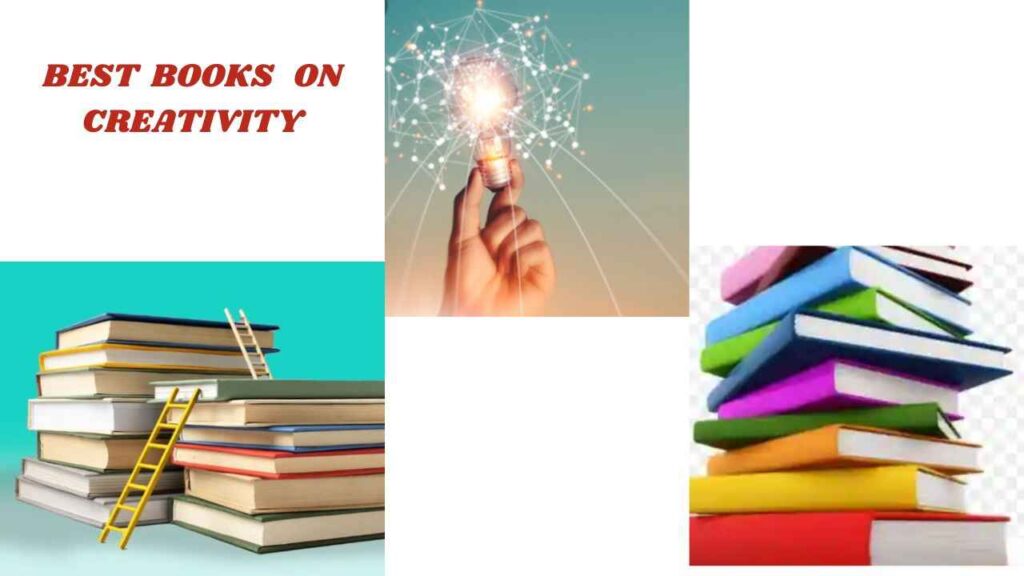
become more creative now
https://youtu.be/HRm6MtUBnU0?si=m0vo9xH4tMQjJeiK
Here are some best books on creativity:
1.” Creativity, Inc.: Overcoming the Unseen Forces That Stand in the Way of True Inspiration” by Ed Catmull:
READ THE BOOK: “Creativity, Inc.: Overcoming the Unseen Forces That Stand in the Way of True Inspiration” by Ed Catmull:
SUMMARY OF THE BOOK: “Creativity, Inc.: Overcoming the Unseen Forces That Stand in the Way of True Inspiration” by Ed Catmull:
Creativity, Inc.” by Ed Catmull is a groundbreaking book that delves into the inner workings of Pixar Animation Studios and explores the principles that drive creativity and innovation. Through the lens of his experiences as a co-founder of Pixar, Catmull shares valuable insights and strategies for overcoming the unseen forces that can hinder creativity. In this article, we’ll delve into the key concepts from “Creativity, Inc.” and how they can inspire and empower individuals to develop their creativity.
Fostering a Culture of Creativity:
One of the central themes of “Creativity, Inc.” is the importance of fostering a culture that nurtures creativity. Catmull emphasizes the need for leaders to create an environment where employees feel empowered to take risks, experiment with new ideas, and collaborate openly. By fostering a culture of trust, respect, and openness, organizations can unlock the full creative potential of their teams.
Embracing Failure as a Learning Opportunity:
Catmull stresses the importance of embracing failure as a natural part of the creative process. He encourages leaders to create a safe space where employees feel comfortable taking risks and making mistakes. By reframing failure as a valuable learning opportunity, organizations can encourage experimentation and innovation, leading to breakthroughs in creativity.
Navigating the Creative Process:
“Creativity, Inc.” offers valuable insights into the creative process and how organizations can navigate the complexities of bringing creative ideas to life. Catmull highlights the importance of collaboration, iteration, and feedback in refining and improving creative projects. By fostering a culture of continuous improvement and adaptation, organizations can overcome obstacles and achieve true inspiration.
Building a Diverse and Inclusive Team:
Catmull emphasizes the importance of building diverse and inclusive teams to foster creativity and innovation. He recognizes that diverse perspectives and experiences bring richness and depth to creative projects, leading to more innovative solutions. By embracing diversity and inclusion, organizations can tap into a wider range of ideas and perspectives, fueling creativity and driving success.
Empowering Creative Leadership:
“Creativity, Inc.” underscores the role of leadership in fostering creativity and innovation within organizations. Catmull emphasizes the importance of leaders who lead by example, empower their teams, and prioritize the creative process. By championing creativity at all levels of the organization, leaders can inspire and motivate their teams to reach new heights of innovation.
“Creativity, Inc.” by Ed Catmull offers valuable insights and strategies for developing creativity and fostering innovation within organizations. By embracing a culture of creativity, embracing failure as a learning opportunity, navigating the creative process effectively, building diverse and inclusive teams, and empowering creative leadership, organizations can unlock their full creative potential and drive success in today’s rapidly evolving world.
READ THE FULL BOOK NOW,
2. “Big Magic: Creative Living Beyond Fear” by Elizabeth Gilbert:
READ THE BOOK:”Big Magic: Creative Living Beyond Fear” by Elizabeth Gilbert:
SUMMARY OF THE BOOK: “Big Magic: Creative Living Beyond Fear” by Elizabeth Gilbert:
Big Magic: Creative Living Beyond Fear” by Elizabeth Gilbert is a transformative book that encourages readers to embrace creativity and live a life driven by passion and inspiration. Through personal anecdotes, practical advice, and insightful reflections, Gilbert shares valuable insights on how to overcome fear, cultivate creativity, and live a life filled with purpose and joy. In this article, we’ll explore the key themes and lessons from “Big Magic” and how they can help individuals develop their creativity and unlock their creative potential.
Embracing Creativity as a Divine Gift:
One of the central themes of “Big Magic” is the idea that creativity is a divine gift that resides within each of us. Gilbert encourages readers to embrace their creative impulses and trust in the magic of inspiration. By recognizing creativity as a sacred and inherent part of our being, individuals can tap into their creative potential and unleash their unique talents and abilities.
Overcoming Fear and Self-Doubt:
Gilbert acknowledges that fear and self-doubt are common obstacles that can hinder creativity. However, she emphasizes the importance of confronting these fears head-on and pushing through resistance to pursue creative endeavors. By reframing fear as a natural and inevitable part of the creative process, individuals can cultivate courage and resilience, allowing their creativity to flourish.
Cultivating Curiosity and Playfulness:
“Big Magic” encourages readers to approach creativity with a sense of curiosity and playfulness. Gilbert advocates for embracing experimentation, exploration, and whimsy in creative pursuits. By adopting a playful mindset and allowing oneself to follow creative whims and impulses, individuals can unlock new possibilities and discover unexpected sources of inspiration.
Honoring the Creative Process:
Gilbert emphasizes the importance of honoring the creative process and committing to the practice of creativity. She encourages readers to show up consistently for their creative work, regardless of external validation or recognition. By cultivating a disciplined and dedicated approach to creativity, individuals can nurture their creative talents and achieve mastery in their chosen endeavors.
Finding Joy in the Creative Journey:
“Big Magic” celebrates the inherent joy and fulfillment that comes from engaging in creative pursuits. Gilbert encourages readers to prioritize joy and passion over external measures of success or achievement. By aligning with what brings them joy and fulfillment, individuals can create a life that is rich with meaning and purpose, infused with creativity and inspiration.
Embracing the Magic of Collaboration:
Gilbert highlights the transformative power of collaboration and connection in the creative process. She encourages readers to seek out community, support, and feedback from fellow creatives. By engaging in collaborative projects and sharing ideas with others, individuals can amplify their creative impact and forge meaningful connections with like-minded souls.
“Big Magic: Creative Living Beyond Fear” offers profound insights and practical wisdom for anyone seeking to develop their creativity and live a life fueled by passion and inspiration. By embracing creativity as a divine gift, overcoming fear and self-doubt, cultivating curiosity and playfulness, honoring the creative process, finding joy in the journey, and embracing the magic of collaboration, individuals can unlock their creative potential and embark on a journey of self-discovery and fulfillment.
READ THE FULL BOOK NOW:
“Big Magic: Creative Living Beyond Fear” by Elizabeth Gilbert:
3. “The War of Art: Break Through the Blocks and Win Your Inner Creative Battles” by Steven Pressfield:
READ THE BOOK:” The War of Art: Break Through the Blocks and Win Your Inner Creative Battles” by Steven Pressfield:
SUMMARY OF THE BOOK: The War of Art: Break Through the Blocks and Win Your Inner Creative Battles by Steven Pressfield:
The War of Art: Break Through the Blocks and Win Your Inner Creative Battles” by Steven Pressfield is a seminal work that delves into the inner struggles faced by creatives and provides actionable insights for overcoming resistance and unlocking creative potential. Through a blend of practical advice, psychological insights, and personal anecdotes, Pressfield illuminates the path to cultivating creativity and achieving artistic success. In this article, we’ll explore the key themes and lessons from “The War of Art” and how they can empower individuals to develop their creativity and realize their artistic dreams.
Understanding Resistance:
Central to “The War of Art” is the concept of resistance—the invisible force that prevents individuals from pursuing their creative aspirations. Pressfield identifies resistance as the primary obstacle standing between artists and their work, manifesting as fear, self-doubt, procrastination, and other forms of self-sabotage. By recognizing resistance as a universal force that affects all creatives, individuals can begin to confront and overcome its grip on their creative lives.
Turning Pro:
Pressfield introduces the concept of “turning pro” as a transformative mindset shift that empowers individuals to fully commit to their creative endeavors. Turning pro entails adopting a professional attitude toward one’s craft, showing up consistently, and treating creative work with the dedication and discipline of a true professional. By embracing the mindset of the professional, individuals can overcome resistance and elevate their creative output to new heights.
Harnessing the Power of Discipline:
Discipline is a recurring theme throughout “The War of Art,” with Pressfield emphasizing its critical role in cultivating creativity and achieving artistic success. He advocates for establishing a daily practice of creativity, committing to a regular schedule, and prioritizing the work above all else. Through disciplined action and unwavering commitment, individuals can break through creative blocks and tap into their full creative potential.
Embracing the Muse:
Pressfield explores the concept of the muse—the mysterious source of inspiration that fuels creative work. He encourages individuals to cultivate a relationship with their muse, showing up each day and inviting inspiration to flow freely. By honoring the muse and remaining open to its guidance, individuals can access deeper levels of creativity and produce work that resonates on a profound level.
Overcoming Self-Doubt and Fear:
“The War of Art” offers valuable insights into overcoming the self-doubt and fear that often accompany the creative process. Pressfield acknowledges the inner critic—the voice of resistance that seeks to undermine creative efforts—and provides strategies for silencing its destructive influence. By reframing fear as a natural part of the creative journey and pushing through self-doubt, individuals can reclaim their creative power and pursue their artistic visions with confidence.
Embracing the Creative Journey:
Ultimately, “The War of Art” celebrates the transformative journey of creativity—the highs and lows, the triumphs and setbacks, and the profound sense of fulfillment that comes from engaging in the creative process. Pressfield encourages individuals to embrace the challenges of creative work, viewing each obstacle as an opportunity for growth and self-discovery. By embracing the creative journey in all its complexity, individuals can develop resilience, cultivate creativity, and ultimately realize their artistic dreams.
“The War of Art” is a powerful manifesto for creatives seeking to overcome resistance, unlock their creative potential, and achieve artistic success. Through its insightful exploration of resistance, discipline, inspiration, self-doubt, and the creative journey, Pressfield offers a roadmap for developing creativity and realizing one’s artistic vision. By applying the principles outlined in “The War of Art,” individuals can break through creative blocks, cultivate discipline, and unleash their creative power to create meaningful and impactful work.
READ THE FULL BOOK NOW,
The War of Art: Break Through the Blocks and Win Your Inner Creative Battles by Steven Pressfield:
4. The Creative Curve: How to Develop the Right Idea at the Right Time by Allen Gannett:
READ THE FULL BOOK: The Creative Curve: How to Develop the Right Idea at the Right Time by Allen Gannett:
SUMMARY OF THE BOOK: The Creative Curve: How to Develop the Right Idea at the Right Time by Allen Gannett:
The Creative Curve: How to Develop the Right Idea at the Right Time” by Allen Gannett is a groundbreaking exploration of the creative process and the factors that contribute to the generation of innovative ideas. Drawing on insights from neuroscience, psychology, and entrepreneurship, Gannett reveals the secrets behind creative success and provides practical strategies for developing creativity. In this article, we’ll delve into the key themes and lessons from “The Creative Curve” and explore how individuals can cultivate their creative abilities to generate breakthrough ideas.
Understanding the Creative Curve:
At the heart of “The Creative Curve” lies the concept of the creative curve—a framework that describes the trajectory of creative ideas from inception to widespread adoption. Gannett argues that creativity follows a predictable pattern, with ideas initially met with skepticism before gaining acceptance and recognition. By understanding the dynamics of the creative curve, individuals can position themselves to capitalize on emerging trends and harness the power of creativity.
The Science of Creativity:
Gannett delves into the science of creativity, debunking common myths and misconceptions surrounding the creative process. Drawing on research from neuroscience and psychology, he explores the cognitive mechanisms that underlie creativity, such as pattern recognition, associative thinking, and divergent thought. By demystifying the creative process and highlighting its neural foundations, Gannett empowers individuals to cultivate their creative abilities and unlock their full creative potential.
The Role of Expertise and Exposure:
One of the key insights from “The Creative Curve” is the importance of expertise and exposure in fostering creativity. Gannett argues that creative genius is not purely innate but is rather the result of deliberate practice and immersive experiences. He cites examples of creative luminaries who achieved mastery in their fields through years of dedicated effort and exposure to diverse influences. By immersing oneself in a domain and engaging deeply with its content, individuals can enhance their creative skills and generate novel ideas.
The Power of Timing:
Timing plays a crucial role in the creative process, as highlighted by Gannett in “The Creative Curve.” He explores the concept of temporal landmarks—moments in time that serve as catalysts for creative breakthroughs—and reveals how individuals can leverage these opportunities to develop innovative ideas. By being attuned to cultural trends, market dynamics, and societal shifts, individuals can identify opportune moments to unleash their creativity and make a meaningful impact.
Cultivating Creativity:
“The Creative Curve” offers practical strategies for cultivating creativity and fostering a conducive environment for idea generation. Gannett emphasizes the importance of curiosity, experimentation, and open-mindedness in nurturing creative thinking. He encourages individuals to embrace failure as a natural part of the creative process and to adopt a growth mindset that prioritizes learning and exploration. By cultivating a culture of creativity and fostering a supportive ecosystem, individuals can create the conditions for innovation to thrive.
The Ethics of Creativity:
In “The Creative Curve,” Gannett grapples with the ethical implications of creativity and innovation, exploring the fine line between inspiration and imitation. He discusses the ethical responsibilities of creators and the importance of integrity, authenticity, and originality in creative endeavors. By adhering to ethical standards and respecting the intellectual property of others, individuals can contribute to a culture of creativity that values integrity and innovation.
“The Creative Curve” offers invaluable insights into the nature of creativity and the principles that govern its development. By understanding the dynamics of the creative curve, embracing expertise and exposure, leveraging timing, cultivating creativity, and upholding ethical standards, individuals can unlock their creative potential and generate breakthrough ideas that shape the future. With its blend of science, psychology, and practical advice, “The Creative Curve” serves as a guiding light for aspiring creators seeking to develop their creativity and make a meaningful impact on the world.
READ THE FULL BOOK NOW,
The Creative Curve: How to Develop the Right Idea at the Right Time by Allen Gannett
5. “Steal Like an Artist: 10 Things Nobody Told You About Being Creative” by Austin Kleon:
READ THE BOOK: “Steal Like an Artist: 10 Things Nobody Told You About Being Creative” by Austin Kleon:
SUMMARY OF THE BOOK:”Steal Like an Artist: 10 Things Nobody Told You About Being Creative” by Austin Kleon:
Steal Like an Artist: 10 Things Nobody Told You About Being Creative” by Austin Kleon is a refreshing manifesto that challenges conventional notions of creativity and offers practical advice for aspiring artists and innovators. Kleon advocates for embracing influence, embracing your inner artist, and cultivating creativity in everyday life. In this article, we’ll explore the key themes and insights from “Steal Like an Artist” and how they can inspire individuals to develop their creative potential.
Embracing Influence:
One of the central tenets of “Steal Like an Artist” is the idea of embracing influence rather than shying away from it. Kleon argues that all creative work is fundamentally derivative, drawing inspiration from the ideas, styles, and techniques of others. By acknowledging and embracing our influences, we can liberate ourselves from the pressure to be wholly original and instead focus on remixing, reimagining, and reinventing existing ideas to create something new and meaningful.
Unlocking Your Inner Artist:
Kleon encourages readers to tap into their inner artist and unleash their creative potential. He dispels the myth of the tortured genius and instead advocates for a more pragmatic and playful approach to creativity. By adopting a mindset of curiosity, experimentation, and play, individuals can overcome creative blocks and unleash their innate creativity. Kleon emphasizes the importance of making time for creative pursuits and nurturing a creative practice that fuels inspiration and innovation.
Embracing Constraints:
Contrary to popular belief, Kleon argues that constraints can actually enhance creativity rather than stifle it. He encourages readers to embrace limitations as creative challenges and opportunities for innovation. By imposing constraints on our creative process—whether it’s time, resources, or medium—we can spark new ideas, foster creative problem-solving, and produce work that is more focused, cohesive, and impactful.
The Power of Stealing:
One of the most provocative ideas in “Steal Like an Artist” is Kleon’s assertion that all artists are thieves—and that’s okay. He argues that creativity is inherently collaborative and that artists are constantly borrowing, remixing, and repurposing ideas from those who came before them. Rather than feeling guilty about borrowing ideas, Kleon encourages readers to embrace the concept of “creative theft” and use it as a springboard for their own creative endeavors.
Finding Your Voice:
While it’s important to draw inspiration from others, Kleon emphasizes the importance of finding and cultivating your own unique voice as an artist. He encourages readers to experiment with different styles, techniques, and mediums until they find what resonates with them personally. By staying true to your authentic self and expressing your unique perspective, you can create work that is meaningful, impactful, and unmistakably yours.
Sharing Your Work:
In “Steal Like an Artist,” Kleon emphasizes the importance of sharing your work with others, even if it’s not perfect. He argues that creativity thrives in community and that sharing your work—whether it’s online, in galleries, or with friends and family—can lead to valuable feedback, collaboration, and opportunities for growth. By embracing vulnerability and putting your work out into the world, you can connect with others, build a supportive network, and continue to evolve as an artist.
“Steal Like an Artist” is a manifesto for anyone seeking to unleash their creativity and make their mark on the world. Through its playful yet profound insights, Austin Kleon challenges readers to embrace influence, unlock their inner artist, and cultivate a creative practice that is authentic, collaborative, and meaningful. Whether you’re a seasoned artist or a novice creator, “Steal Like an Artist” offers invaluable wisdom and inspiration for developing your creative potential and creating work that resonates with others.
READ THE FULL BOOK NOW,
“Steal Like an Artist: 10 Things Nobody Told You About Being Creative” by Austin Kleon:
6. “Bird by Bird: Some Instructions on Writing and Life” by Anne Lamott:
READ THE BOOK:6. “Bird by Bird: Some Instructions on Writing and Life” by Anne Lamott:
SUMMARY OF THE BOOK:”Bird by Bird: Some Instructions on Writing and Life” by Anne Lamott:
In “Bird by Bird: Some Instructions on Writing and Life,” Anne Lamott offers a heartfelt and humorous exploration of the writing process and its parallels to life itself. Drawing from her own experiences as a writer and teacher, Lamott shares invaluable insights and practical advice for nurturing creativity, overcoming self-doubt, and embracing the messy, imperfect journey of artistic expression. In this article, we’ll delve into the key themes and lessons from “Bird by Bird” and how they can inspire individuals to develop their creativity and live more fulfilling lives.
The Importance of Starting Small:
One of the central concepts in “Bird by Bird” is the idea of tackling creative projects “bird by bird,” or one small step at a time. Lamott encourages writers to focus on the present moment and break daunting tasks down into manageable increments. By embracing a step-by-step approach to creativity, individuals can overcome feelings of overwhelm and inertia and make progress toward their goals, one small victory at a time.
Embracing Imperfection:
Lamott emphasizes the importance of embracing imperfection and allowing oneself to create “shitty first drafts.” She argues that the pursuit of perfection can be paralyzing and stifling to creativity. Instead, she encourages writers to give themselves permission to write badly, knowing that the real magic happens in the revision process. By letting go of unrealistic expectations and embracing the messiness of the creative process, individuals can free themselves to explore new ideas and express themselves authentically.
Cultivating Mindfulness:
Throughout “Bird by Bird,” Lamott emphasizes the importance of cultivating mindfulness and paying attention to the world around us. She encourages writers to observe life with curiosity and openness, drawing inspiration from everyday experiences and interactions. By practicing mindfulness, individuals can tap into a deeper well of creativity and find beauty and meaning in the seemingly mundane moments of life.
Navigating Self-Doubt:
Lamott acknowledges the pervasive presence of self-doubt in the creative process and offers strategies for navigating its turbulent waters. She reassures writers that self-doubt is a natural part of the creative journey and that it doesn’t have to define or derail their work. Instead of succumbing to self-doubt, Lamott encourages writers to acknowledge their fears, cultivate self-compassion, and continue moving forward with courage and persistence.
The Power of Community:
In “Bird by Bird,” Lamott underscores the importance of community and support in nurturing creativity. She encourages writers to seek out like-minded individuals who can offer encouragement, feedback, and camaraderie on the creative journey. Whether through writing groups, workshops, or online forums, finding a supportive community can provide invaluable support and accountability for writers as they navigate the ups and downs of the creative process.
Embracing the Messiness of Life:
At its core, “Bird by Bird” is a celebration of the messy, unpredictable nature of life itself. Lamott reminds readers that creativity is messy, imperfect, and inherently human. By embracing the messiness of life—both on and off the page—individuals can cultivate resilience, adaptability, and a deeper sense of connection to themselves and others.
“Bird by Bird: Some Instructions on Writing and Life” by Anne Lamott is a heartfelt and humorous meditation on the creative process and the art of living. Through its candid and compassionate insights, Lamott offers a roadmap for developing creativity, overcoming self-doubt, and finding fulfillment in the messy, imperfect journey of artistic expression. Whether you’re a seasoned writer or someone seeking to cultivate creativity in your daily life, “Bird by Bird” offers invaluable wisdom and inspiration for navigating the challenges and joys of the creative journey.
READ THE FULL BOOK NOW,
“Bird by Bird: Some Instructions on Writing and Life” by Anne Lamott
7. The Artist’s Way: A Spiritual Path to Higher Creativity by Julia Cameron:
READ THE BOOK:” The Artist’s Way: A Spiritual Path to Higher Creativity” by Julia Cameron:
SUMMARY OF THE BOOK:The Artist’s Way: A Spiritual Path to Higher Creativity by Julia Cameron:
The Artist’s Way: A Spiritual Path to Higher Creativity” by Julia Cameron is a transformative guide that empowers individuals to tap into their innate creativity and live more fulfilling lives. Through a blend of spiritual teachings, practical exercises, and personal anecdotes, Cameron offers a roadmap for unlocking creativity and overcoming the barriers that stand in the way of artistic expression. In this article, we’ll delve into the key themes and insights from “The Artist’s Way” and explore how it can inspire individuals to develop their creativity and embrace their truest selves.
Discovering Creative Potential:
One of the central tenets of “The Artist’s Way” is the belief that everyone is inherently creative, regardless of their background or profession. Cameron encourages readers to reconnect with their creative selves and reclaim the joy of artistic expression. Through a series of exercises and reflections, she guides readers on a journey of self-discovery, helping them uncover hidden talents, passions, and aspirations that may have been buried beneath layers of self-doubt and societal conditioning.
Cultivating Creative Practices:
“The Artist’s Way” emphasizes the importance of establishing regular creative practices as a means of nurturing creativity and fostering personal growth. Cameron introduces tools such as morning pages—daily journaling exercises designed to clear the mind and access inner wisdom—and artist dates—solo excursions intended to spark inspiration and replenish the creative well. By committing to these practices, readers can cultivate a deeper connection to their creativity and integrate artistic expression into their daily lives.
Navigating Creative Blocks:
Throughout “The Artist’s Way,” Cameron addresses common obstacles that can impede creative expression, such as fear, self-criticism, and perfectionism. She offers strategies for overcoming these challenges and reclaiming creative autonomy. By reframing negative beliefs, practicing self-compassion, and embracing imperfection, readers can break free from creative blocks and rediscover the joy of artistic experimentation.
Honoring the Creative Process:
Cameron emphasizes the importance of embracing the creative process as a sacred journey of self-discovery and growth. She encourages readers to trust their instincts, follow their passions, and cultivate a sense of curiosity and wonder in their creative endeavors. By letting go of expectations and surrendering to the flow of inspiration, individuals can access a deeper well of creativity and express themselves authentically.
Nurturing Creative Community:
“The Artist’s Way” underscores the value of community and collaboration in nurturing creativity. Cameron encourages readers to seek out supportive networks of fellow artists and creatives who can offer encouragement, feedback, and camaraderie on the creative journey. Whether through in-person workshops, online forums, or creative retreats, cultivating a sense of community can provide invaluable support and inspiration for individuals seeking to develop their creativity.
Embracing the Spiritual Dimension:
At its core, “The Artist’s Way” is a spiritual guide to creativity, inviting readers to explore the deeper dimensions of their creative selves. Cameron emphasizes the connection between creativity and spirituality, encouraging readers to cultivate practices such as meditation, prayer, and gratitude to deepen their creative connection. By embracing spirituality as a source of inspiration and guidance, individuals can tap into a profound sense of purpose and meaning in their creative pursuits.
“The Artist’s Way: A Spiritual Path to Higher Creativity” by Julia Cameron is a profound and inspiring guide to unlocking creativity and living a more authentic, fulfilling life. Through its blend of spiritual teachings, practical exercises, and personal anecdotes, Cameron empowers readers to reconnect with their creative selves, overcome obstacles, and embrace the transformative power of artistic expression. Whether you’re an aspiring artist, a seasoned creative, or simply someone seeking to live more creatively, “The Artist’s Way” offers timeless wisdom and practical tools for developing creativity and living a life of purpose and passion.
READ THE BOOK NOW,
The Artist’s Way: A Spiritual Path to Higher Creativity by Julia Cameron:

